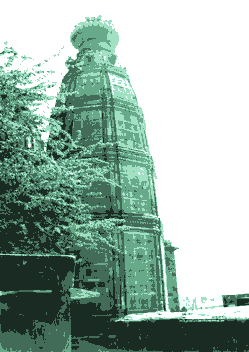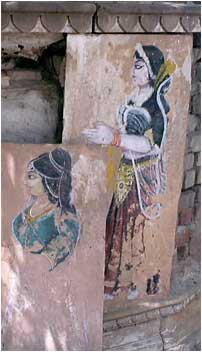
The roots of the Gaudiya Vaishnava tradition lie several millenia in the past of India. The four Vedas, Rig, Sama, Yajur and Atharva, the Purana-epics illustrating the precepts of the Vedas, and the vast Mahabharata narrating the story of Krishna and the Pandava-brothers, in which the famous Bhagavad-gita is included, form the ancient basis of the Gaudiya Vaishnava tradition.
The Gaudiya Vaishnava tradition is a part of a larger section of Hinduism known as Vaishnavism. The Vaishnavas understand Vishnu, the Almighty Supreme, as the preserving and purpose-giving God of existence. Some Vaishnava-traditions focus on God in his divinely magnificent Vishnu-form, while others accept the all-enchanting form of Krishna as the object of their worship. The devotional religions of India are collectively known as the bhakti-tradition.
THE FOUR VAISHNAVA-TRADITIONS
The ancient Vaishnava-tradition felt a breeze of renewal around 1000 CE as four great Vaishnava-teachers presented their commentaries on the essence of Vedanta and taught the same to their numerous followers. They were Vishnusvami (born ca. 700 CE) who founded his own school; Ramanuja (1017-1137 CE), who founded a tradition known as the Sri-sampradaya, basing his views on the teachings of the Alvar-saints of the past and forming a theology called visishta-advaita; Nimbarka (ca. 1100 CE), who founded his own tradition; as well as Madhva (1199-1278 CE), who also offered his own interpretation of Vedanta, establishing his own theology known as dvaita.
THE BHAKTI-MOVEMENTS OF THE 16th CENTURY
The renaissance of Vaishnavism began in the early 1600's as Sri Krishna Chaitanya Mahaprabhu (1486-1534 CE) started his bhakti-movement in West Bengal in the district of Nadia. Despite having been initiated in the Madhva-tradition, Sri Chaitanya practically founded his own tradition, having marked differences with the practices and the theology of the Madhvites as he taught of devotion for Radha and Krishna, the divine couple of Vrindavan. The followers of Chaitanya took him to be the embodiment of Radha and Krishna who had descended to this world to show the path for attaining the devotional service of Radha and Krishna, the ultimate goal of life.
Vallabha (1479-1531 CE) was a contemporary of Chaitanya, who founded one of the most influential traditions of Northern India. The Vallabha-tradition claims a connection with the branch of Vishnusvami. The traditions of Chaitanya and Vallabha seem to have had much in common over their first two generations. During these years many others, such as Hit Harivamsha (1502-1553 CE) and Swami Haridas (1480-1575 CE), founded their own traditions, not particularly claiming for a connection with the older traditions. The famous female saint and poet, Mirabai (1498-1547 CE), was influential during this time.
THE ASSOCIATES OF SRI CHAITANYA
Sri Chaitanya spent the first 24 years of his life in Navadvipa, West Bengal. Most of Chaitanya's followers knew him since his early years. For example Advaita (1454-1550 CE), a leading figure among the Vaishnavas of Navadvipa from before Chaitanya's birth, and Nityananda (1473-1545 CE), a charismatic and eccentric saint, arose to key roles in creating the future of Chaitanya's tradition. Gadadhara Pandit and Vakresvara Pandit, Chaitanya's companions since his childhood, Narahari Cakravartin of Sri Khanda, Nityananda's wife Jahnava, along with many others, contributed their share in initiating the tradition. Disciplic lines descending from the associates of Chaitanya form the majority of the modern Gaudiya Vaishnava - tradition.
Chaitanya spent the remainder of his life, another 24 years, in Jagannath Puri in the company of some of his intimate followers, such as Svarupa Damodara and Ramananda Raya, steeped in deep devotional rapture. During those years, he practically demonstrated the pinnacle of devotional attainment in both his words and his deeds.
SRI CHAITANYA AND THE SIX GOSWAMIS OF VRINDAVAN
Sri Chaitanya is not known to have written anything but a series of verses known as the Siksastaka, the eight verses of instruction. He requested a select few among his followers, who later came to be known as the Six Goswamis of Vrindavan, to systematically present in their writings the theology of bhakti he had taught.
These six saints and theologians were Rupa Goswami, Sanatana Goswami, Gopala Bhatta Goswami, Raghunatha Bhatta Goswami, Raghunatha Das Goswami and Jiva Goswami. In his writings, Rupa focused particularly in explaining the principles of the sacred rapture of devotion, Sanatana along with Gopala Bhatta wrote of the rituals of the tradition, Raghunatha Das focused on the esotera of raganuga-bhajan, and Jiva, the most voluminous author among the six, wrote the elaborate theological thesis known as the Sat-sandarbha among other works.
THE NEXT GENERATION OF THE TRADITION
Narottama Das Thakur, Srinivasa Acarya and Syamananda Pandit were among the stalwarts of the second generation of Gaudiya Vaishnavism. Having studied under Jiva, they were instrumental in propagating the teachings of the Goswamis throughout Bengal, Orissa and other regions of Eastern India. Many among their associates, such as Ramacandra Kaviraja and Ganga-narayana Cakravartin, were also eminent teachers in their own right.
The famous festival of Kheturi, presided over by Jahnava Thakurani, the wife of Nityananda, was the first time the leaders of the various branches of Chaitanya's followers assembled together. Through such festivals, members of the loosely organized tradition became acquainted with other branches along with their respective theological and practical nuances. That notwithstanding, the tradition has maintained its plural nature, having no central authority to preside over its matters.
Around these times, the descendants of Nityananda and Advaita, headed by Virabhadra and Krishna Mishra respectively, started their family-lineages (vamsha) to maintain the tradition. The vamsha descending from Nityananda through Virabhadra forms the most prominent branch of the modern Gaudiya tradition, though descendants of Advaita, along with the descendants of many other associates of Chaitanya, maintain their following especially in the rural areas of Bengal.
Gopala Guru Goswami, a young associate of Chaitanya and a follower of Vakreshwar Pandit, founded another branch based in Orissa. The writings of Gopala Guru, along with those of his disciple Dhyanacandra Goswami, have had a substantial influence on the methods of internal worship in the tradition.
17th AND 18th CENTURIES
The period following the earliest generations of the tradition gave rise to many a controversy in its course. Vishwanath Chakravarti, an illustrious teacher whose period of influence began in late 17th century, is credited with resolving major theological conflicts surrounding the practice of raganuga-bhajan and the nature of the amorous relationship between Radha and Krishna. His student, Baladeva Vidyabhushan, hailing from a disciplic line descending from Rasikananda, authored the famous Govinda Bhashya commentary on Vedanta-sutra in defense of the Gaudiya sampradaya in the royal assembly of Jaipur in early 18th century.
Across the 18th century, descendants of the various vamshas of Chaitanya's companions continued their endeavors in furthering Sri Chaitanya's cause in their respective locales around Bengal. During this period, many illustrious saints, among whom perhaps the most influential was Siddha Krishna Das Babaji of Govardhan, guided the community of devotees in Vraja on matters of bhajan – an influence that carries to the present day.
TOWARDS EARLY 20th CENTURY
The 19th century India, now under substantial influence from the West with the establishment of the British rule, reflected on its values and cultural heritage in diverse avenues. Vaishnavism was not unaffected – this was to be an era of new movements and revolutionaries.
The need to influence the colonisers was felt strongly among the Bengali intelligentsia. This spirit touched Kedarnath Datta Bhaktivinoda, a deputy magistrate under the British government, who sent an English biography of Chaitanya's he had authored in 1896 to numerous Western universities. The first missionary to cross the ocean was Baba Premananda Bharati, a follower of Jagatbandhu Sundar's, who arrived in the United States in 1902, establishing a Krishna-temple in Los Angeles and, according to some accounts, raising up to 5000 followers. His disciple, Mahanambrata Brahmachari, was to lecture in dozens of universities across the country in the 1930's. Their Western following is said to have later dwindled under religious persecution in their absence.
Radharaman Charan Das Babaji, also known as Boro Baba, was one of the leading characters of the era, gathering a substantial following of his own. This group, popularized further through the efforts of Ramdas Babaji, is known for their "Nitai Gaura Radhe Shyam" chant. Despite some doctrinal disagreements, Boro Baba's followers have gained acceptance among the tradition.
In 1919, Bhaktisiddhanta Sarasvati founded a monastic movement called Gaudiya Matha. Under his inspiration, Bhaktihridoy Bon and Bhaktipradip Tirtha journeyed to England for missionary work, meeting with only limited success. Over the next two decades to follow, until his departure in 1936, Bhaktisiddhanta propagated his reformist movement across India and vocally expressed his dissatisfaction over the current state of the tradition, and purportedly offered sharp critique of both the householder gurus in the vamsha-traditions and the babaji-renunciates. This spirit, accompanied with some theological revisions, led the majority of the tradition to distance itself from the new movement.
As printing presses grew more popular and became more readily available, the old literature of the tradition, earlier available only as hand-written manuscripts, was widely published in a printed form. Perhaps the greatest among publishers was Haridas Dasji of Haribol Kutir, who spent the entirety of his life searching, editing and translating old manuscripts for publication. Other stalwart publishers were Puri Das, known from his days in Gaudiya Matha as Ananta Vasudeva, and Krishna Das Babaji of Kusuma Sarovara.
THE MODERN DAY
The tradition settled on the Western soil for good with the efforts of A.C. Bhaktivedanta Swami, who reached the United States in 1965. The people of the love-and-flowers decade, filled with curious subcultures and a search for spirituality, were open for the Swami's message, and the movement spread rapidly across the continents. Bhaktivedanta's movement, ISKCON – International Society for Krishna Consciousness – otherwise known as the Hare Krishna movement, has translated and published his literature in dozens of languages over the decades.
Inspired by the success, some other followers of Bhaktisiddhanta Saraswati have also established their respective movements in the Western hemisphere. Others have, learning of the Gaudiya tradition and often after meeting representatives of the aforementioned movements, traveled to the sacred places of India, such as Vraja in northern India and Navadwipa in Bengal, in search of the roots of the tradition. The classical alignments of the Gaudiya Vaishnava tradition are yet to see organized activity on a larger scale in the West – quite possibly owing to the trend of priorizing individual spiritual growth over dedicated missionary work.
In its motherland, the diverse branches of the classical tradition are largely going on the way they have been for the past century. With the increased availability of communication facilities, knowledge of these original flag-bearers of the heritage is gradually becoming available for the global audience as well.
[ Return to top ]




